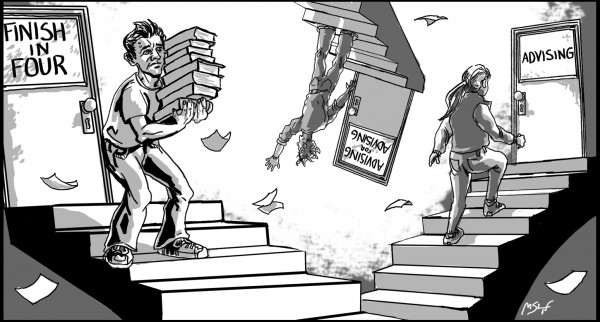
In her State of the University Address, SUNY Chancellor Nancy Zimpher said she wants to increase graduation rates 60 percent from 93,000 to 150,000 by the year 2020. In part of this goal, she wishes to institute Finish in Four, a program thats main objective is to have incoming first-years graduate in four years.
We at The New Paltz Oracle applaud Chancellor Zimpher for proposing ways in which to alleviate the burdens students face while trying to finish their degree in a timely manner. However, addressing this issue with a fancy alliterative name as a building block to create 57,000 more graduates each year undermines the severity of a problem that has been going on for years within the SUNY system.
Yes, many students find it difficult to finish their undergraduate degree within a four year time frame. Yet while the overall purpose of the program works to benefit SUNY students, the ways in which it is implemented should be carefully considered; ideas that look good on paper may mask any foreseeable faults.
The foundation of the proposed Finish in Four plan is to have advisers assigned to guide each student through the process of completing a required program for career aptitude, finding a major, registering for the correct courses and maintaining a close relationship with the student throughout their time at the college, keeping them on track.
That sounds eerily similar to what our current advisers are meant to do, but often fail to accomplish. Many times advisers will not be available to speak, authorize class choices that are not conducive for the student’s time or academic success and offer little guidance on what classes should be taken and when. We hope that some form of training or protocol is done when selecting these advisers to ensure that they have the students’ best interests in mind and act accordingly.
Chancellor Zimpher’s plan also promises that SUNY will pay for classes that are unavailable to a student at the time in which they need to take it, leading to a free class but the posibility of falling off the four year path.
Instead of SUNY sending out what are essentially “I’m Sorry” notes in the form of free classes, taking a closer look at major requirements and the availability of corresponding classes seems like a more worthy cause. If this is meant to deter SUNY schools from lacking the sufficient amount of classes for each major each semester, there is probably a much more cost efficient way to do so.
In an adjacent plant, Chancellor Zimpher also calls for SUNY advisers to be placed in high schools in conjunction with current guidance counselors to assist with college advising, beginning in low income school districts and eventually becoming a staple in every New York State high school. These advisers, along with an online course that explains to families application processes like admission requirements and financial aid, will help high school students explore options and make plans for their futures. For students who fear the price of higher education or are perhaps the first in their families to attend college, these additions are key to expanding options, increasing enrollment and ultimately increasing graduation rates.
But whether the watchful eye of Finish in Four begins for a student in high school or as they enter their freshman year of college, the student may feel the structure and requirements that must be upheld are too much. College is a time of exploration, and expecting 17 and 18-year-olds to create an unwavering plan of action to ensure a graduation date based on a career they may not even be sure about does not seem reasonable.
Each student has a unique idea of what they want from their academic college experience. While some students will undoubtedly enjoy having the structure and reassurance that they can obtain a degree of their choosing in four years so long as they adhere to the Finish in Four plan, others may feel overwhelmed and trapped. Why require General Education (GE) courses if not to expand our interests and spark curiosity? Insisting that an undergraduate student finish their GE’s and decide their major within their first few semesters in order to ensure they will graduate on time is unrealistic.
If Finish in Four comes to fruition on our campus, we hope that the program is not simply seen as a stepping stone to obtaining higher graduation rates, but as a program with purpose in and of itself that will better the college experience of future students who choose to attend a SUNY school.
